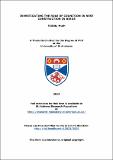Files in this item
Investigating the role of cognition in nest construction in birds
Item metadata
| dc.contributor.advisor | Healy, Sue | |
| dc.contributor.author | Muth, Felicity | |
| dc.coverage.spatial | 159 | en_US |
| dc.date.accessioned | 2013-06-26T15:04:35Z | |
| dc.date.available | 2013-06-26T15:04:35Z | |
| dc.date.issued | 2013 | |
| dc.identifier | uk.bl.ethos.574858 | |
| dc.identifier.uri | https://hdl.handle.net/10023/3820 | |
| dc.description.abstract | Nest building in birds has long been assumed to be a behaviour that is not learned, despite suggestive evidence to the contrary. In this thesis I investigated the role of learning in nest building in birds. I focused primarily on the choice of nest material made by zebra finches, in particular between two or more colours of nesting material. Using this aspect of behaviour, I found that adult nest building birds changed their preference for a particular colour of nesting material depending on their own nesting and breeding experience: males that built a nest using material of their less preferred colour later preferred that colour following a successful breeding attempt in that nest. In contrast to this role for learning in adults, in two other experiments I found no evidence that juvenile birds learned about the nest from which they had fledged or that birds learned about what material to nest with from conspecifics. Using wild Southern masked weavers, I also addressed variability in a particular aspect of nest building: the attachment of the very first blade of grass knotted onto a branch. I found that birds did not construct the same attachment each time they did it, even when building at the same location, but that males generally used more loops in their attachments as they built more nests, and when using longer pieces of grass. Finally, I tested zebra finches on a nest building ‘task’, using a paradigm often used to test cognitive abilities among tool-users. Birds were presented with two lengths of nest material, one of which was more appropriate for one of two sizes of nest box entrance. I found that nesting birds could choose the appropriate length of material and that the birds’ handling of material and their choice of material changed with experience. Taking these results together, it seems that there is a greater role for learning in nest construction than is generally acknowledged and that nest building might involve the same underlying cognitive processes as tool manufacture and use. | en_US |
| dc.language.iso | en | en_US |
| dc.publisher | University of St Andrews | |
| dc.subject.lcc | QL698.3M8 | |
| dc.subject.lcsh | Nest building--Psychological aspects | en_US |
| dc.subject.lcsh | Weavebirds--Psychology | en_US |
| dc.subject.lcsh | Cognition in animals | en_US |
| dc.title | Investigating the role of cognition in nest construction in birds | en_US |
| dc.type | Thesis | en_US |
| dc.contributor.sponsor | Carnegie Trust for the Universities of Scotland | en_US |
| dc.type.qualificationlevel | Doctoral | en_US |
| dc.type.qualificationname | PhD Doctor of Philosophy | en_US |
| dc.publisher.institution | The University of St Andrews | en_US |
This item appears in the following Collection(s)
Items in the St Andrews Research Repository are protected by copyright, with all rights reserved, unless otherwise indicated.

